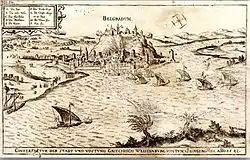Stefan Berislavić
Stefan Berislavić (Serbian: Стефан Бериславић, Hungarian: Beriszló István, b. c. 1505 - d. 1535) was titular Despot of Serbia, between 1520 and 1535, and a prominent nobleman in southern counties (Syrmia, Valkó and Požega) of the Kingdom of Hungary.[1][2][3]
| Stefan Berislavić | |
|---|---|
| titular Despot of Serbia | |
| Despot of Serbia | |
| Reign | 1520–1535 |
| Predecessor | Ivaniš Berislavić |
| Successor | Pavle Bakić |
| Born | c. 1505 |
| Died | 1535 |
| House | Ivaniš Berislavić |
| Mother | Jelena Jakšić |
Life
Stefan Berislavić was member of the Berislavići noble family,[4] from the Požega County (central region of modern Slavonia). Stefan was the elder son of Ivaniš Berislavić (d. 1514), who served as titular Despot of Serbia (1504–1514), and Ban of Jajce (1511–1513).[5]
Stefan′s mother was Jelena Jakšić, of the Serbian Jakšić noble family, who had previously been married to Jovan Branković, the last Serbian Despot of the Branković dynasty (1496–1502). As Jelena and his first husband had no male issue, the title of Serbian Despot became vacant upon Jovan′s death in 1502. When Jelena remarried to Ivaniš Berislavić in 1504, he received the title, from Hungarian king Vladislaus II (d. 1516), and held it until his death in 1514.[6][7]
Stefan was c. nine years old when his father died, and thus the title of Serbian Despot was granted to him only in 1520, by the Hungarian king Louis II (d. 1526).[8] After the Ottoman conquest of Belgrade in 1521, he tried to hold his fortress of Kupinik in Syrmia county, but the region was eventually lost to Ottoman invasion.[9]
After the defeat at the Battle of Mohács (1526), Kingdom of Hungary became divided between two rival fractions; one was led by King Ferdinand Habsburg, while the other was led by John Zápolya, the Duke of Transylvania, who was also proclaimed King. At first, Stefan Berislavić supported Zapolja (1526), but soon opted for Ferdinand, at the beginning of 1527. Learning of that, Zapolja tried to suppress Stefan′s authority over Serbs by appointing Serbian nobleman Radič Božić as titular Despot of Serbia (1527–1528). In spite of that, Stefan continued to act as Serbian Despot, and was recognized as such by King Ferdinand. In 1529, Stefan fell out of Ferdinand′s favor and was confined in Buda, but soon escaped.[10][11]
At that time, Ferdinand′s territories in Hungary were invaded again by the Ottomans, who acted as allies of rival king John Zápolya, ruler of the Eastern Hungarian Kingdom. Stefan decided to join them, and in return received confirmation of his domains. Since 1529, he controlled frontier regions in Slavonian Posavina, centered in Brod. During 1532 and 1533, he negotiated again with king Ferdinand, but no agreement was reached. In 1535, he came in conflict with Ottoman governor of Bosnia. During the invasion, Stefan was killed by janissary, and his domain was conquered by the Ottomans.[12][13]
Ancestors
| Ancestors of Stefan Berislavić | ||||||||||||||||||||||||||||||||||||||||||||||||||||||||||||||||||||||||||||||||||||||||||||||||||||||||||||||||||||||||||||||||||||||||||||||||||||||||||||||||||||||||||||||||||||||||||||||||||||||||||||||||||||||
|---|---|---|---|---|---|---|---|---|---|---|---|---|---|---|---|---|---|---|---|---|---|---|---|---|---|---|---|---|---|---|---|---|---|---|---|---|---|---|---|---|---|---|---|---|---|---|---|---|---|---|---|---|---|---|---|---|---|---|---|---|---|---|---|---|---|---|---|---|---|---|---|---|---|---|---|---|---|---|---|---|---|---|---|---|---|---|---|---|---|---|---|---|---|---|---|---|---|---|---|---|---|---|---|---|---|---|---|---|---|---|---|---|---|---|---|---|---|---|---|---|---|---|---|---|---|---|---|---|---|---|---|---|---|---|---|---|---|---|---|---|---|---|---|---|---|---|---|---|---|---|---|---|---|---|---|---|---|---|---|---|---|---|---|---|---|---|---|---|---|---|---|---|---|---|---|---|---|---|---|---|---|---|---|---|---|---|---|---|---|---|---|---|---|---|---|---|---|---|---|---|---|---|---|---|---|---|---|---|---|---|---|---|---|---|
| ||||||||||||||||||||||||||||||||||||||||||||||||||||||||||||||||||||||||||||||||||||||||||||||||||||||||||||||||||||||||||||||||||||||||||||||||||||||||||||||||||||||||||||||||||||||||||||||||||||||||||||||||||||||
| Regnal titles | ||
|---|---|---|
| Preceded by Ivaniš Berislavić |
titular Despot of Serbia 1520–1535 |
Succeeded by Pavle Bakić |
Annotations
References
- Ивић 1929.
- Ћирковић 1982, p. 479–490.
- Karbić 2006, p. 79-84.
- Karbić 2006, p. 71-85.
- Karbić 2006, p. 76-78.
- Jireček 1918, p. 256.
- Krstić 2017, p. 152.
- Jireček 1918, p. 257.
- Fodor & Dávid 2000, p. 80-81.
- Ћирковић 1982, p. 484, 487.
- Karbić 2006, p. 80-82.
- Ћирковић 1982, p. 488.
- Karbić 2006, p. 82-84.
- Karbić 2006, p. 79-85.
- Thallóczy & Áldásy 1907, p. 47-48, 110-113, 357-362.
Sources
- Ćirković, Sima (2004). The Serbs. Malden: Blackwell Publishing.CS1 maint: ref=harv (link)
- Dávid, Géza; Fodor, Pál, eds. (1994). Hungarian-Ottoman Military and Diplomatic Relations in the Age of Süleyman the Magnificent. Budapest: Loránd Eötvös University, Hungarian Academy of Sciences, Institute of History.CS1 maint: ref=harv (link)
- Engel, Pál (2001). The Realm of St. Stephen: A History of Medieval Hungary, 895-1526. London & New York: I.B.Tauris.CS1 maint: ref=harv (link)
- Ивић, Алекса (1929). Историја Срба у Војводини од најстаријих времена до оснивања потиско-поморишке границе (1703). Нови Сад: Матица српска.CS1 maint: ref=harv (link)
- Fine, John Van Antwerp Jr. (1994) [1987]. The Late Medieval Balkans: A Critical Survey from the Late Twelfth Century to the Ottoman Conquest. Ann Arbor, Michigan: University of Michigan Press.CS1 maint: ref=harv (link)
- Fodor, Pál; Dávid, Géza, eds. (2000). Ottomans, Hungarians, and Habsburgs in Central Europe: The Military Confines in the Era of Ottoman Conquest. Leiden: BRILL.CS1 maint: ref=harv (link)
- Jireček, Constantin (1918). Geschichte der Serben. 2. Gotha: Perthes.CS1 maint: ref=harv (link)
- Karbić, Marija (2006). "Hrvatsko plemstvo u borbi protiv Osmanlija: Primjer obitelji Berislavića Grabarskih iz Slavonije". Povijesni prilozi. 31: 71–85.
- Krstić, Aleksandar R. (2017). "Which Realm will You Opt for? – The Serbian Nobility Between the Ottomans and the Hungarians in the 15th Century". State and Society in the Balkans Before and After Establishment of Ottoman Rule. Belgrade: Institute of History, Yunus Emre Enstitüsü Turkish Cultural Centre. pp. 129–163.CS1 maint: ref=harv (link)
- Margalits, Ede (1918). Szerb történelmi repertorium (PDF). Budapest: Magyar Tudományos Akadémia.CS1 maint: ref=harv (link)
- Pálosfalvi, Tamás (2018). From Nicopolis to Mohács: A History of Ottoman-Hungarian Warfare, 1389-1526. Leiden: BRILL.CS1 maint: ref=harv (link)
- Rezar, Vlado, ed. (2001). Ludovici Tuberonis Dalmatae Abbatis Commentarii de temporibus suis. Zagreb: Hrvatski institut za povijest.CS1 maint: ref=harv (link)
- Thallóczy, Lajos; Áldásy, Antal, eds. (1907). Magyarország és Szerbia közti összeköttetések oklevéltára 1198-1526. Budapest: Magyar Tudományos Akadémia.CS1 maint: ref=harv (link)
- Ћирковић, Сима (1982). "Последњи деспоти". Историја српског народа. књ. 2. Београд: Српска књижевна задруга. pp. 479–490.CS1 maint: ref=harv (link)
